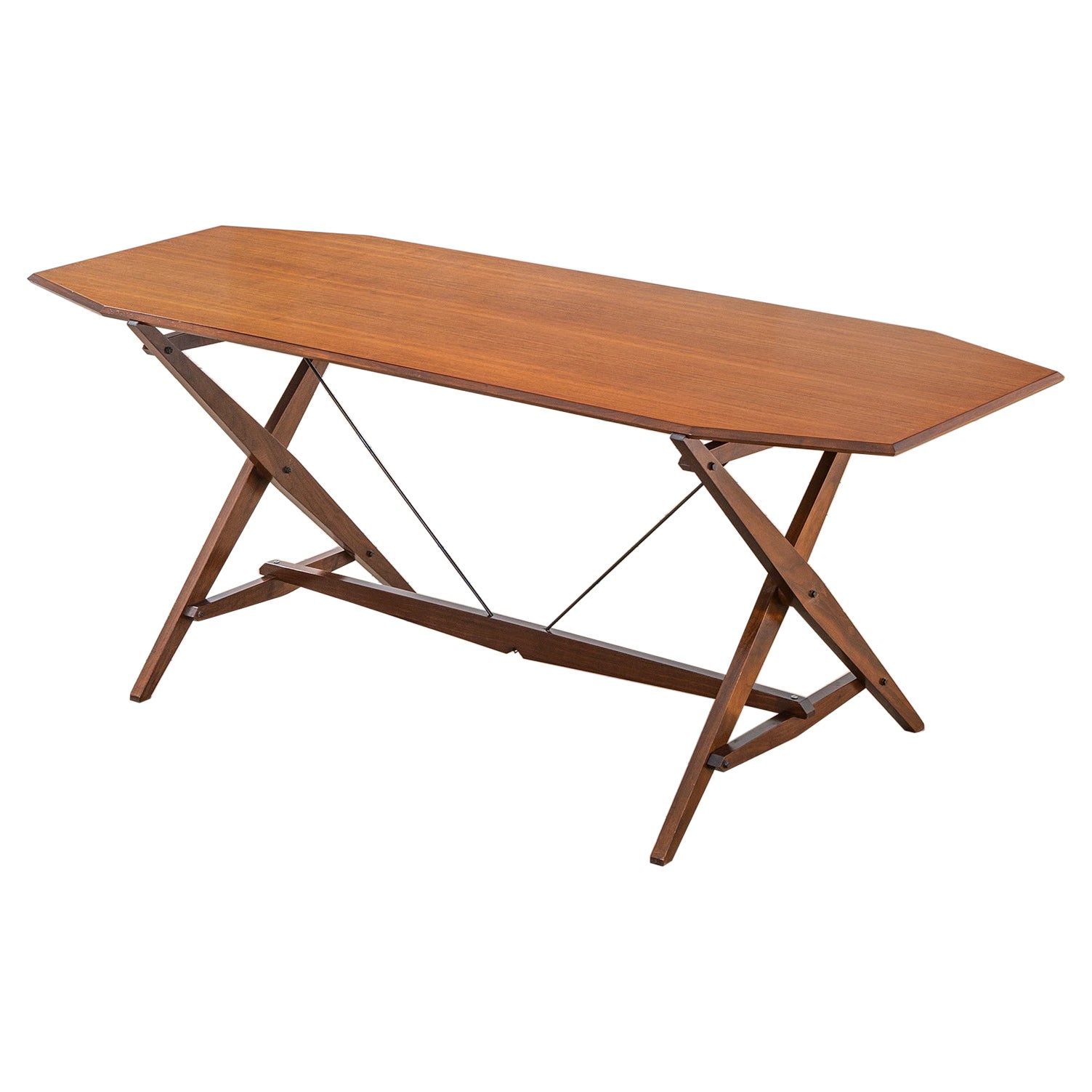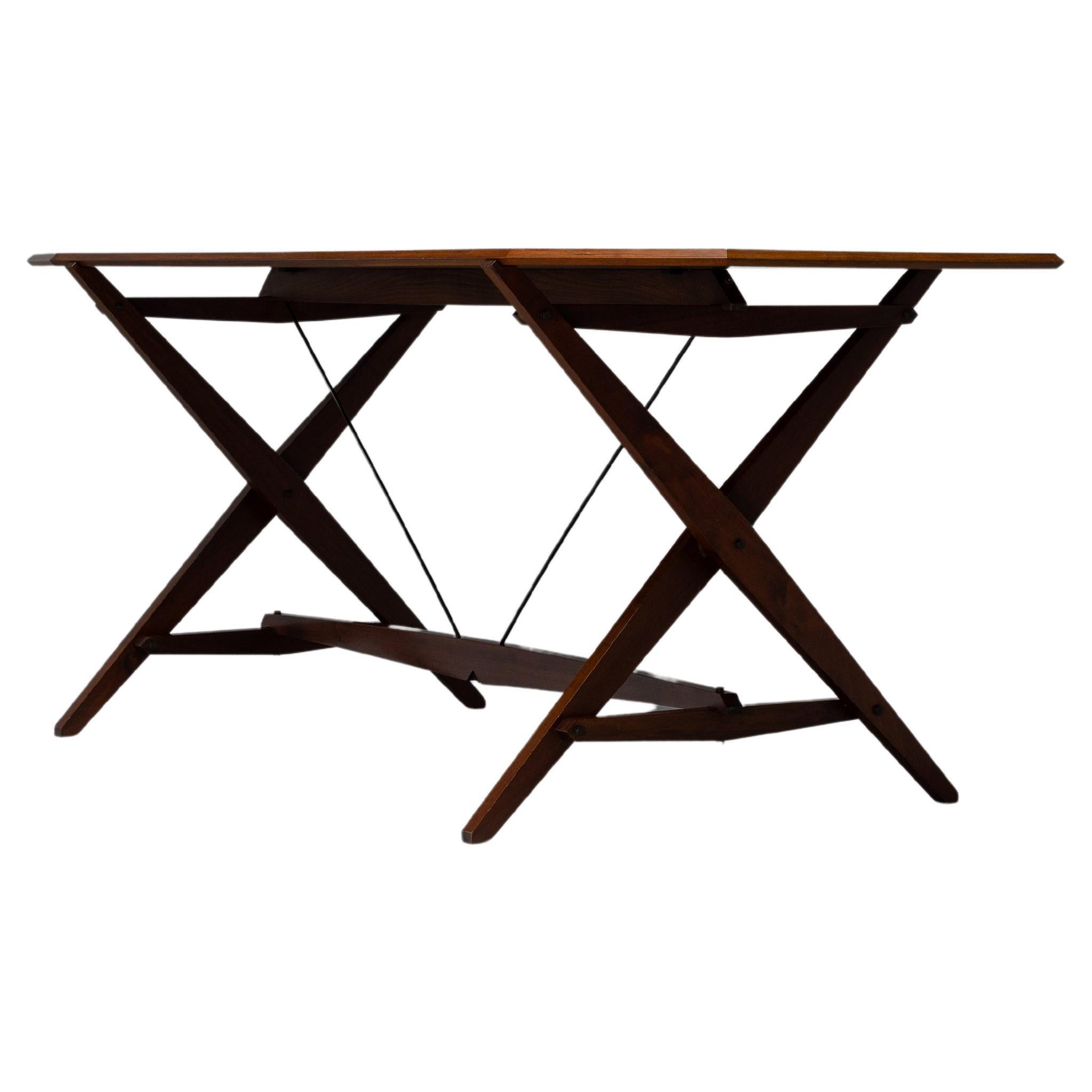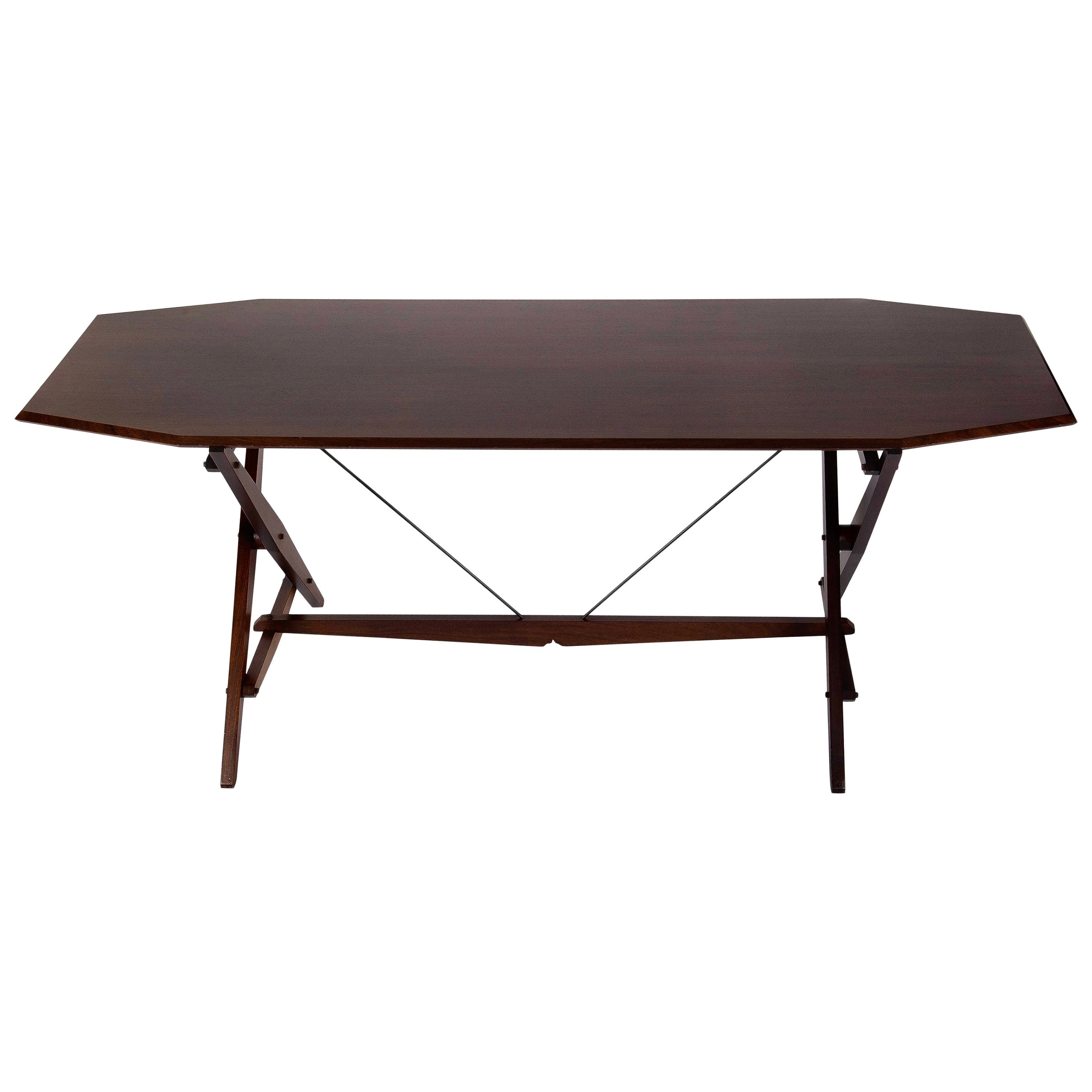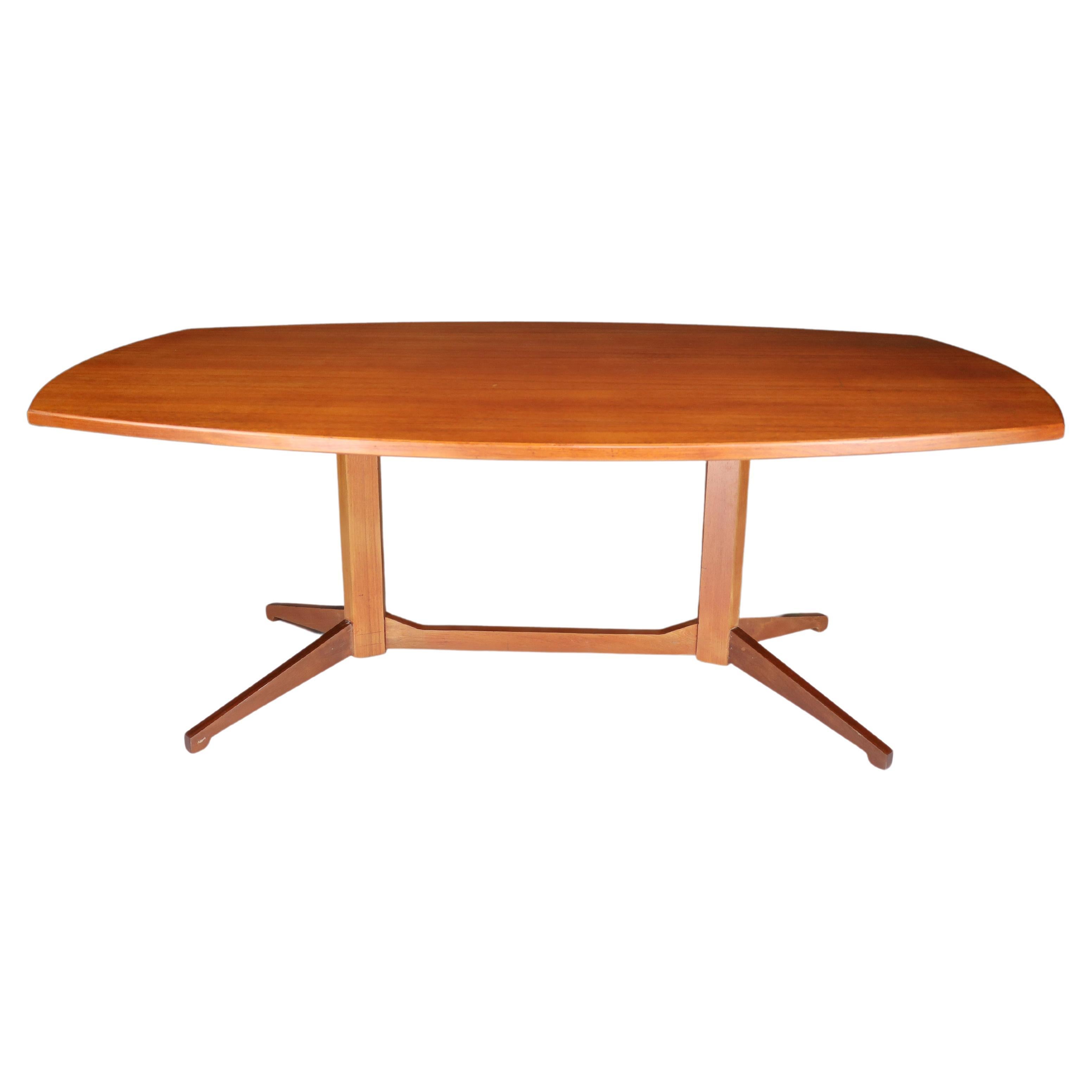Franco Albini Mahogany mid-centry Italian Table Model TL-22 produced by Poggi
About the Item
- Creator:Franco Albini (Designer)
- Dimensions:Height: 28.75 in (73 cm)Width: 40.95 in (104 cm)Depth: 70.87 in (180 cm)
- Style:Mid-Century Modern (Of the Period)
- Materials and Techniques:
- Place of Origin:
- Period:
- Date of Manufacture:1958
- Condition:Wear consistent with age and use.
- Seller Location:Barcelona, ES
- Reference Number:1stDibs: LU237436278033
Franco Albini
While working under the polymath Gio Ponti — arguably the most important figure in 20th-century Italian modernism — furniture designer Franco Albini nurtured a love for modern forms combined with traditional craft techniques.
Albini is widely known for working with organic materials such as rattan and cane for his chairs and other seating, but he also played a pivotal role in the Italian rationalist movement of the early 20th century, which saw architects and furniture makers applying a strict emphasis on geometry in their work. Rationalists drew on Ancient Roman architecture but rejected ornament, much in the way that Le Corbusier and celebrated Bauhaus figures such as Ludwig Mies van der Rohe had in their modernist furniture.
Albini received his degree in architecture from the Polytechnic University of Milan in 1929, and, in 1931, he founded his practice in Milan, where he tackled workers’ housing and other reconstruction projects. A gifted urban planner, he also developed the Palazzo Bianco, Palazzo Rosso and Tesoro di San Lorenzo museums in Genoa. While Albini is revered for his Margherita chair — a Triennale Milano award winner created for Bonacina in 1951 — he also collaborated with manufacturers Poggi and Cassina in the 1940s on seating, tables and more that embodied his artistic vision. Of that mid-century work, the one piece that perhaps best captures this vision is the iconic Luisa chair.
With its cherry red upholstery and sinuous wooden legs that seem to float aboveground, the Luisa is a genuine masterpiece. It is also a testament to Albini’s perfectionism, as it endured several prototypes — including one made by Knoll in the late 1940s — and took approximately 15 years to design. Poggi launched the final version of the armchair in 1955, earning Albini the prestigious Compasso d’Oro from Italy’s Association for Industrial Design. It is produced today by Cassina. Albini named the chair for someone who likely saw the process firsthand: his personal secretary of two decades, Luisa Colombini.
Find vintage Franco Albini furniture on 1stDibs.
- ShippingRetrieving quote...Ships From: Casavells , Spain
- Return PolicyA return for this item may be initiated within 2 days of delivery.
- Table lamp model “524" by Franco Albini, Italy, 1952By Franco AlbiniLocated in Barcelona, ESTable lamp model “524” Made in collaboration with Franca Helg Manufactured by Arteluce Italy, 1952 Openwork Perspex in a chrome frame Measurements 41 Ø cm x 47h cm. 16,14 Ø in x 18,5...Category
Vintage 1950s Italian Table Lamps
MaterialsChrome
- Carlo Scarpa, Small Dining Table Model “Quatour”, Walnut, Italy 1974By Carlo ScarpaLocated in Barcelona, ESCarlo Scarpa Dining table model “Quatour” Manufactured by Simon Gavina Italy, 1974 Walnut wood Measurements: 141 cm x 141 cm x 72 H cm 55.9 in x 55.9 in x 28 H in. Litera...Category
Vintage 1970s Italian Dining Room Tables
MaterialsWalnut
- Franco Albini Set of Six Midcentury Brazilian Dining Chairs jacaranda and fabricBy Forma Brazil, Franco AlbiniLocated in Barcelona, ESFranco Albini (1905-1977) Set of six dining chairs with arms (Price per chair) Manufactured by Forma Brazil Brazil, 1950s Solid jacaranda wood and fabric Measurements 58 cm x 55 c...Category
Mid-20th Century Brazilian Mid-Century Modern Dining Room Chairs
MaterialsUpholstery, Jacaranda
- Office Desk model “Square” by Joaquim Tenreiro, 1966By Joaquim TenreiroLocated in Barcelona, ESOffice Desk model "Square" Manufactured by Tenreiro Moveis e Decoraçao Brazil, 1966 Jacaranda, Glass Measurements 100 cm x 100 cm x 76h cm 39,3 in x 39,3 in x 29,9h in Detail This ...Category
Vintage 1960s Brazilian Desks and Writing Tables
MaterialsGlass, Jacaranda
- Sergio Rodrigues Round Wooden Dining Table "Stella" Oca mid-century Brazil 1956By Oca, Sergio RodriguesLocated in Barcelona, ESSergio Rodrigues (1927-2014) Round dining table model “Stella” Manufactured by Oca Brazil, 1956 Jacaranda wood, brass, iron Measurements 122 cm diameter x 73 height cm 48 in diamet...Category
Mid-20th Century Brazilian Mid-Century Modern Dining Room Tables
MaterialsBrass, Iron
- Côme Clérino Contemporary Ceramic Tiled Wall Desk Model "Le Solitaire Blue" 2021By Côme ClérinoLocated in Barcelona, ESWall desk model "Le Solitaire Blue" Manufactured by Côme Clérino Produced in exclusive for Side Gallery Paris (France), 2021 Polystyrene, stainless, steel, plaster, oakum, ceramic, enamel, tile joint, electronic components, polyester resin, fiberglass, wood and PU foam. Measurements 76 cm x 69 cm x 58h cm (18 cm depth desk shut) 29,92 in x 27,16 in x 22,83h in (7 in depth desk shut) Edition Unique Piece Côme Clérino (1990, Paris) lives in Paris and works in Pantin, France. After graduating from the École Nationale Supérieure des Beaux-Arts de Paris in 2016, he developed a multidisciplinary practice shaking up the academic definition of painting and integrating photography, drawing, sculpture, ceramics, textiles and installation. In 2017, he presented his first solo exhibition, Voir au verso, at Les Gens Heureux gallery in Copenhagen. In 2018, after a new solo exhibition, Emulsilfy(ing), at the Castellana 22 gallery in Madrid, he was nominated for the International Painting Prize of Vitry-sur-Seine. In 2019, he presented his first solo show in France, Et si on passait les meubles par la fenêtre?, at the Double V Gallery...Category
21st Century and Contemporary French Shelves and Wall Cabinets
MaterialsCeramic, Resin, Fiberglass, Foam, Plaster, Wood
- 20th Century Franco Albini Table Model TL2 "Cavalletto" in Wood for Poggi 1950sBy Poggi, Franco AlbiniLocated in Turin, TurinIconic table designed by the great Italian maestro Franco Albini in the 50s. The model is TL2 better known as "Cavalletto" (in english "Trestle") since it reminds of lightness and wi...Category
Vintage 1950s Italian Mid-Century Modern Dining Room Tables
MaterialsMetal
- Franco Albini TL2 Cavalletto table Poggi Italy 1950By Franco AlbiniLocated in Roosendaal, Noord BrabantIconic and early example of the TL2 'Cavalletto' table designed by Franco Albini and manufactured by Poggi in Italy around 1950. The table has an amazing dynamic and archtectural sha...Category
Vintage 1950s Italian Mid-Century Modern Desks and Writing Tables
MaterialsBrass
- Wooden Dining Table TL22 Model by Franco Albini for Poggi 60sBy Franco Albini, PoggiLocated in Padova, ITWooden dining table TL22 model by Franco Albini for Poggi 60s. Born in Milan in 1905, Franco Albini is an Italian architect, urban planner and furniture designer, active between the 1930s and 1960s. He studied at the Milan Polytechnic and completed his apprenticeship under the guidance of the architect and designer Gio Ponti, and played a key role in the formulation of the Italian Rationalist movement in the years before the Second World War. Albini works with several well-known mid-century manufacturers, among which Cassina, Arflex, Poggi, Arteluce, Brionvega, and Knoll stand out, and many of his designs are still in production today. He has received many honors for his work, including three Compasso d'Oro. The professional story of the furniture maker Roberto Poggi...Category
Vintage 1960s Italian Mid-Century Modern Dining Room Tables
MaterialsWood
- Rare Mahogany 'TL2' Cavalletto Table / Desk by Franco Albini for Poggi, ItalyBy Franco Albini, PoggiLocated in London, GBA rare mahogany version of the Cavaletto or TL2 table designed by the great neo-rationalist designer, Franco Albini. Designed in 1950 for manufacturers Poggi...Category
Vintage 1950s Italian Mid-Century Modern Desks and Writing Tables
MaterialsSteel
- Franco Albini for Poggi Table or Desk, Italy, 1960sBy Franco Albini, PoggiLocated in Almelo, NLFranco Albini for Poggi table or desk, Italy, 1960s Walnut table TL22 model by Franco Albini for Poggi Italy 1960s. It is in excellent condition, with a minor patina on the wood parts. This unique table or desk would be an eye-catching addition to any interior, such as a living room, family room, screening room, or office. It also perfectly fits in a hospitality or corporate location like a boutique hotel lobby or luxury loft. When you choose for used mid...Category
Mid-20th Century Italian Mid-Century Modern Dining Room Tables
MaterialsWood, Walnut
- Model Tl2 Desk / Dining Table by Franco Albini for Poggi, Italy, 1951By Franco Albini, PoggiLocated in Skokie, ILFranco Albini model TL2 desk or dining table for Poggi, Italy, 1950s Franco Albini for Poggi, dining table model TL2, walnut and metal, Italy, 1951. The TL2 table by Franco Alb...Category
20th Century Italian Mid-Century Modern Dining Room Tables
MaterialsPalisander






